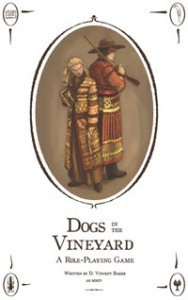Lessons From The Dice Bag – Something They Can’t Ignore

Earlier this week, you heard about an important lesson I learned from the Smallville roleplaying game about relationship-driven drama and the addition of weird elements. Today, I'm excited to talk about a strange, independently published game called Dogs in the Vineyard. The lesson I learned here seems like it should be obvious, and yet just moving it from the background to the foreground of my mind has made a big difference in my writing.
 Dogs in the Vineyard
Dogs in the VineyardSo the premise of Dogs is kinda strange, but it isn't really germane to this post. I'll just put the Wikipedia link right here and you can go read more about it or not as you like. It's a pretty great game, though.
The fascinating part for the purposes of this blog post is the conflict mechanic and what it requires from the players. A pool of dice are rolled and then the conflict takes turns in a manner similar to a poker hand.
The first person to make a move sets the number, which must be met or beaten in as few dice as possible from the opponent's pool. This is called a See. The opponent then declares what she does by pushing two dice forward to set a new target number. This is called a Raise.
So an argument might consist of Point from Player A (first play), Response from Player B (See), Counterpoint from Player B (Raise), Response from Player A (See), Counterpoint from Player A (Raise), etc. The number of dice you See with decides if you take Fallout from the altercation. That part isn't important for this post, but it's how you take "damage" in the game.
The bit that impacted my writing was what the book said about Raises. Whatever the Raise is on the dice (and the rules cover everything from a conversation up to a gunfight with the same mechanic), in the fiction, it has to be something the other person cannot ignore.
Like comparing his mother to a dog of the female persuasion.
Or a public accusation of wrongdoing.
Or getting manhandled out a door.
Or a knife shoved in your gut.
Or a gun pointed in your face.
Have you ever read a book or story where two characters are having a conversation and nothing is really happening in it? Like you know from the narrative that there's a conflict underneath the chatter, only you totally can't see that from what's being said? They have to be arguing or throwing plates or screaming, but the back-and-forth of the conversation certainly isn't bringing the conflict to the fore.
Sometimes the characters are even reacting as though they're getting angry or going on the defensive, but you honestly can't tell why that is from the words used. I see this a lot, and it boggles my mind because nobody would write a fistfight or a shootout this way. Yet it happens to dialogue all the time.
Then I ran into Dogs. The conflict was supposed to be driving the boring conversation, but each character kept saying things the other side could ignore. Both sides kept talking, but the words weren't driving or pointing toward the conflict, and we, the readers, therefore don't understand why anything that's happening is happening. Or even why we should care.
Keep the Dogs advice about Seeing in mind whenever you're writing anything from a discussion on up to fullscale warfare and watch the sparks fly. Go back through any scene that's meant to have conflict, especially the talky ones, and make sure that each side is saying things the other cannot ignore. Then make damn sure the opposing character isn't ignoring it.
You can trust me when I say this because I've seen it a hundred times at the gaming table: If you run a scene like this, then the conflict can still be under the surface but the bubbles boiling to the top will make sure nobody forgets it's down there.
And that's one helluva lesson from the dice bag!



